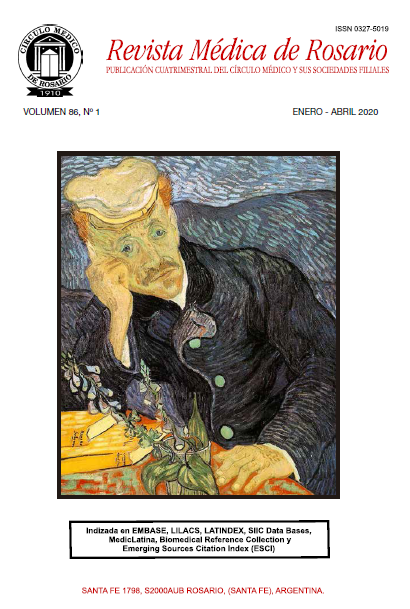Desempeño del SOAR como predictor de severidad de la neumonía adquirida en la comunidad
Palabras clave:
Neumonia mortalidad, Índice de gravedad de la enfermedad, Valor predictivo de las pruebas, Infecciones adquiridas en la comunidadResumen
Objetivo: Evaluar el desempeño del score SOAR como predictor de severidad en la neumonía adquirida en la comunidad (NAC), y de forma comparativa con los scores CURB-65 e Índice de Gravedad de la Neumonía (PSI).
Pacientes y Método: Es un estudio retrospectivo, observacional, de corte transversal. Incluyó pacientes mayores de 14 años con diagnóstico al ingreso de NAC durante un año calendario. Se calculó CURB-65, PSI y el SOAR al ingreso. Se valoró la gravedad de la NAC evaluando el requerimiento de terapia intensiva, necesidad de asistencia mecánica ventilatoria o muerte intrahospitalaria.
Resultados: Se incluyeron 274 pacientes, 178 (65.0%) hombres, edad promedio 49±18.1 años. Presentaron bacteriemia 62 (22.6%) pacientes, siendo el Streptococcus pneumoniae el microorganismo aislado más frecuentemente (n=30, 48.4%). El score SOAR fue eficaz para valorar ingreso a UCI en la NAC con un OR: OR=7.7. IC=3.8-15.6 (p<0.001), y requerimiento de ARM con un OR=9.9. IC=4.2-23.5 (p<0.001). El score SOAR predijo mortalidad eficazmente (p<0.001), con un OR: 12.2 IC: 3.9-38.1, S: 89.5%, E: 76.5%, VPP: 26.3%, VPN: 98.0% aunque el PSI y el CURB-65 fueron superiores, con un OR: 26.6 y 32.4 respectivamente.
Conclusión: Un puntaje de score SOAR clasificado como severo (≥2 puntos) indica riesgo aumentado para formas severas de NAC. El score SOAR puede utilizarse de forma alternativa o complementaria, en conjunto al indispensable juicio médico.
Descargas
Citas
Bartlett JG, Dowell SF, Mandell LA. Practice guidelines for the management of community-acquired pneumonia in adults. Infectious Diseases Society of America. Clin Infect Dis 31:347-82, 2000.
Thomas CP, Ryan M, Chapman JD y col. Incidence and cost of pneumonia in medicare beneficiaries. Chest 142:
-81, 2012.
Fine MJ, Hough LJ, Medsger AR y col. The hospital admission decision for patients with community-acquired pneumonia. Results from the pneumonia Patient Outcomes Research Team cohort study. Arch Intern Me 157:36-44, 1997.
Fine MJ, Smith DN, Singer DE. Hospitalization decision in patients with community-acquired pneumonia: a prospective cohort study. Am J Med 89:713-21, 1990.
Lim WS, van der Eerden MM, Laing R y col. Defining community acquired pneumonia severity on presentation to hospital: an international derivation and validation study. Thorax 58:377-82, 2003.
Niederman MS, Mandell LA, Anzueto A y col. Guidelines for the management of adults with community-acquired pneumonia. Diagnosis, assessment of severity, antimicrobial therapy, and prevention. Am J Respir Crit Care Med 163:1730-54, 2001.
Ewig S, Ruiz M, Mensa J y col. Severe communityacquired pneumonia. Assessment of severity criteria. Am J
Respir Crit Care Med 158:1102-8, 1998.
British Thoracic S, Myint PK, Kamath AV y col. Severity assessment criteria recommended by the British Thoracic Society (BTS) for community-acquired pneumonia (CAP) and older patients. Should SOAR (systolic blood pressure, oxygenation, age and respiratory rate) criteria be used in older people? A compilation study of two prospective cohorts. Age Ageing. 35:286-91, 2006.
Subramanian DN, Musonda P, Sankaran P y col. Performance of SOAR (systolic blood pressure, oxygenation,
age and respiratory rate) scoring criteria in communityacquired pneumonia: a prospective multi-centre study. Age Ageing 42:94-7, 2013.
Fine MJ, Singer DE, Hanusa BH y col. Validation of a pneumonia prognostic index using the MedisGroups
Comparative Hospital Database. Am J Med 94:153-9, 1993.
Mandell LA, Wunderink RG, Anzueto A y col. Infectious Diseases Society of America/American Thoracic Society
consensus guidelines on the management of communityacquired pneumonia in adults. Clin Infect Dis 44 Suppl
:S27-72, 2007.
Boussekey N, Leroy O, Alfandari S y col. Procalcitonin kinetics in the prognosis of severe community-acquired
pneumonia. Intensive Care Med 32:469-72, 2006.
Muller F, Christ-Crain M, Bregenzer T y col. Procalcitonin
levels predict bacteremia in patients with communityacquired pneumonia: a prospective cohort trial. Chest 138:121-9, 2010.
Flanders SA, Stein J, Shochat G y col. Performance of a bedside C-reactive protein test in the diagnosis of communityacquired pneumonia in adults with acute cough. Am J Med 116:529-35, 2004
Holm A, Nexoe J, Bistrup LA y col. Aetiology and prediction of pneumonia in lower respiratory tract infection
in primary care. Br J Gen Pract 57:547-54, 2007.
Fine MJ, Smith MA, Carson CA y col. Prognosis and outcomes of patients with community-acquired pneumonia. A meta-analysis. JAMA 275:134-41, 1996.
Nuorti JP, Butler JC, Farley MM y col. Cigarette smoking and invasive pneumococcal disease. Active Bacterial Core Surveillance Team. N Engl J Med 342:681-9, 2000.
Atlas SJ, Benzer TI, Borowsky LH y col. Safely increasing the proportion of patients with community-acquired
pneumonia treated as outpatients: an interventional trial. Arch Intern Med 158:1350-6, 1998.
Yealy DM, Auble TE, Stone RA y col. Effect of increasing the intensity of implementing pneumonia guidelines: a randomized, controlled trial. Ann Intern Med 143:881- 94, 2005.
España PP, Capelastegui A, Gorordo I y col. Development and validation of a clinical prediction rule for severe
community-acquired pneumonia. Am J Respir Crit Care Med 174:1249-56, 2006.
Vohra AS, Tak HJ, Shah MB y col. Intensive Care Unit Admission With Community-Acquired Pneumonia. Am J
Med Sci 350:380-6, 2015.
Chalmers JD, Singanayagam A, Hill AT. Predicting the need for mechanical ventilation and/or inotropic support for young adults admitted to the hospital with communityacquired pneumonia. Clin Infect Dis 47:1571-4, 2008.
Lim WS, Macfarlane JT. Defining prognostic factors in the elderly with community acquired pneumonia: a case controlled study of patients aged > or = 75 yrs. Eur Respir J 17:200-5, 2001.
Jain S, Self WH, Wunderink RG y col. CommunityAcquired Pneumonia Requiring Hospitalization among U.S. Adults. N Engl J Med 373:415-27, 2015
Publicado
Cómo citar
Número
Sección
Licencia
Licencia Atribución-CompartirIgual 4.0 Internacional (CC BY-SA 4.0)
https://creativecommons.org/licenses/by-sa/4.0/deed.es






